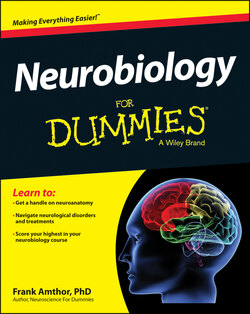Читать книгу Neurobiology For Dummies - Frank Amthor - Страница 54
Coding for proteins: RNA and DNA
ОглавлениеProtein synthesis is the process by which cells generate proteins from the code in the DNA sequence. It occurs in several stages, including transcription from DNA to messenger RNA (mRNA), and translation, or the assembly of proteins by ribosomes using the mRNA template. (RNA is a nucleotide like DNA, except is has the nucleotide uracil substituted for thymine.) This section explores these stages.
The DNA molecule is a double-stranded helix. It’s well suited for storing and replicating biological information because the two strands are complementary. An adenine in one strand is always bound to a thymine in the other, and likewise for guanine and cytosine, called base pairing. This complementary structure enables replication by splitting the two DNA strands, so each forms a new complement strand. The double helix is stable and resistant to cleavage, allowing the body’s trillions of cells to store the genetic code.
